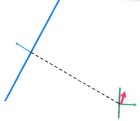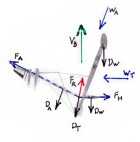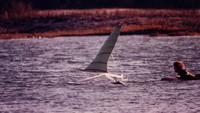High-Speed Sailing
| Vessel Name: | Sailien |
| Vessel Make/Model: | Experimental/custom |
28 September 2013
The America’s Cup
I watched, with interest, the videos of the 34th America’s Cup. At last we have fast sailboats engaged in a competition that is fun to watch. The virtual images (such as course boundaries, distance grid lines, separation between boats, etc.) overlaid on the real images really helps to keep the race [...]
31 August 2013
100 Knots for Hydroptere?
The latest news from Hydroptere is that they have plans for a 100 knot sailboat. This was posted on 26 Aug 2013, so look for that date at this address. http://hydroptere.com/en/the-news/last-news/
17 November 2012
Aptly named Sailrocket, blasts off!
While yet to be ratified, Sailrocket posted an average speed over 500 meters of 59 knots. I will not be surprised if they increase their record into the 60 knot range during this record attempt.
02 January 2012
More drag for VSR2?
I want to start by pointing out that the whole VSR2 team has done a stellar job and has demonstrated conclusively that the forces that drive a sailboat can be aligned for roll stability without using ballast and without using any down-force. (Trifoiler achieved roll stability by using down-force, but [...]
18 December 2011
My analysis of Sailrocket
I copied a diagram of VSR2 (wing doesn’t show well) and added in the major force arrows that apply. Be aware that these arrows are not correct in terms of scale (length) and some of their locations are guesses, however I believe I’m correct enough for us to learn something about what VSR2 has been [...]
23 October 2011
60 is within reach, what’s next?
I have been watching Sailrocket’s progress with great interest and there’s no question they have a winner. I fully expect to see them reach 60kt in the near future. Sailrocket has now demonstrated what I first learned with my models and again with my full-sized prototypes, that if you get the forces [...]
The Water's "Squeeze"
First let me point out that essentially the same thing is happening in the water as in the air, except that normally the air mass is moving (wind blowing) and the water is still. By the way, if the water is moving (river, etc.) and the air is still, you can sail just as well, the sailboat can't tell the difference.
If you take a canoe paddle, dip it in the water and move it very, very slowly, you will note that it takes very little effort to move the paddle through the water. You can push that paddle in any direction with little effort if the motion is slow enough. However if you push the paddle faster, you will notice that it becomes difficult to move the flat side forward but it's still easy to move the thin edge forward. This difference in the amount of effort it takes to move the paddle in those two directions is what we use to sail our boat in any direction, except straight down wind. The paddle is essentially the same as our hydrofoil (keel, centerboard, etc.) on our boat and it resists going sideways but is easy to move forward. This resistance to sideways motion is very slight at very low speed but becomes increasingly strong as we go faster. Note that this resistance to sideways motion is essentially the same as the resistance of the iceboat's runner and the land yacht's tire to sideways motion, and that the hydrofoil, the runner and the tire have low resistance to forward motion.
I want you to observe that if an ice/land yacht is not moving and you try to push it sideways it will have essentially the same resistance to sideways motion as when it is moving forward. On the other hand, the hydrofoil of a sailboat has almost no resistance to sideways motion when it's not moving, but as its speed forward increases, it's resistance to sideways motion keeps increasing. I alluded to the implication of this in my post of 11 May 08 "Hooking the Water".
As our sailboat's forward speed increases and it's resistance to sideways motion increases, our hydrofoil is "cutting" through the water (essentially the same as our airfoil through the air) and our boat is being squeezed between the wind's force on the airfoil (sail) and the water's force on the hydrofoil.
I hope I have done an adequate job of explaining this; I should include drawings and may develop this more fully at a later date. I suggest you do sketches to better grasp the relationships. Finally, please ask if any point is not clear, since I have tried to sketch this out as briefly as possible.
Bob
About & Links
- Bob's Surfing Blog
- Bob's Website
- Greenbird (Windjet)
- l'Hydroptere
- Le Projet Dared
- Macquarie Speed Sailing Team
- Monofoil Sailing
- Mountain Goat STOL
- Mr Smith's Amazing Sailboats
- Patent Office (Search)
- Radboat
- Sailien Prototypes (early), Delta, etc.
- Sailien Video
- Sailien Website
- The Basics of Surfboard Design
- The Basics of Surfboard Design en Espanol
- The Swedish Speed-Sailing Challenge
- Trifoiler
- Vestas Sailrocket
- Windjet Project
- WSSRC


